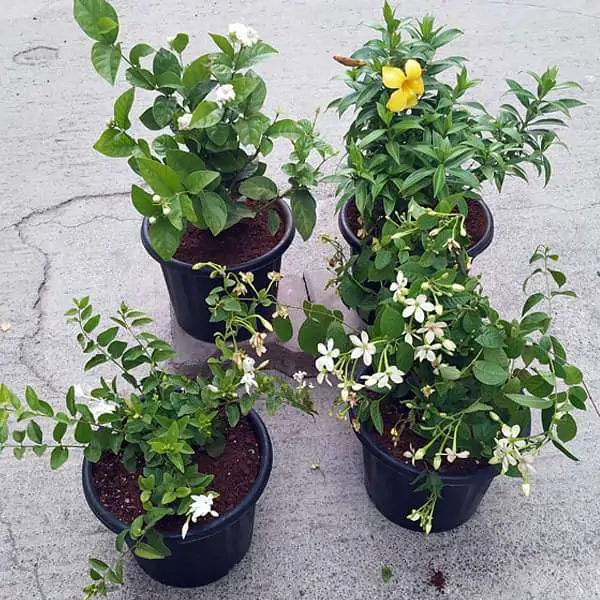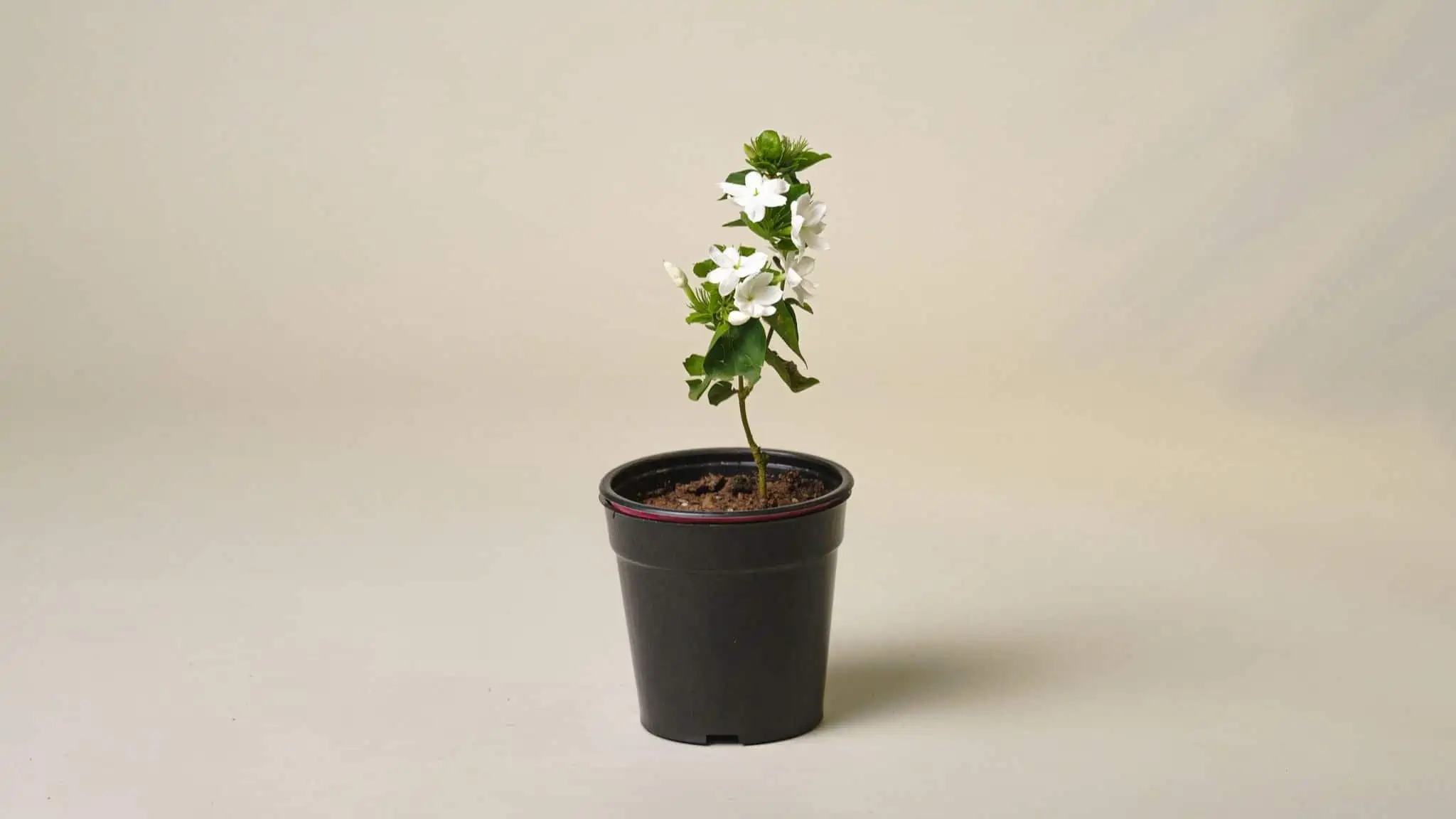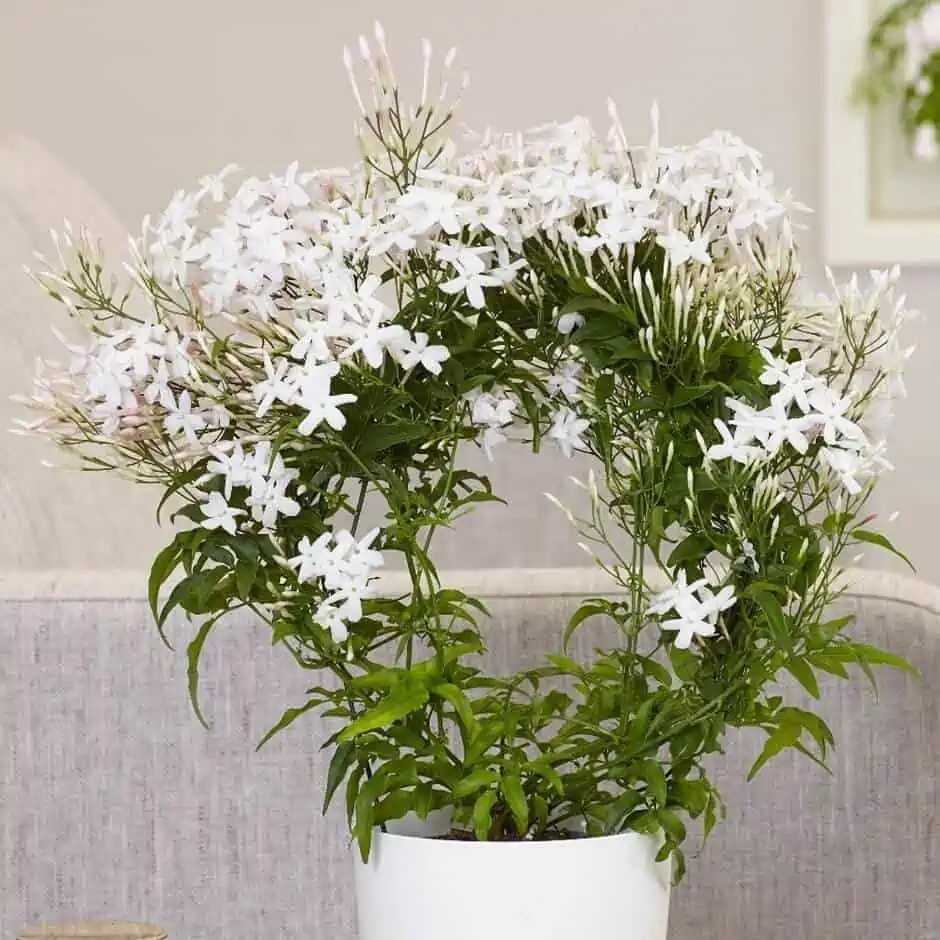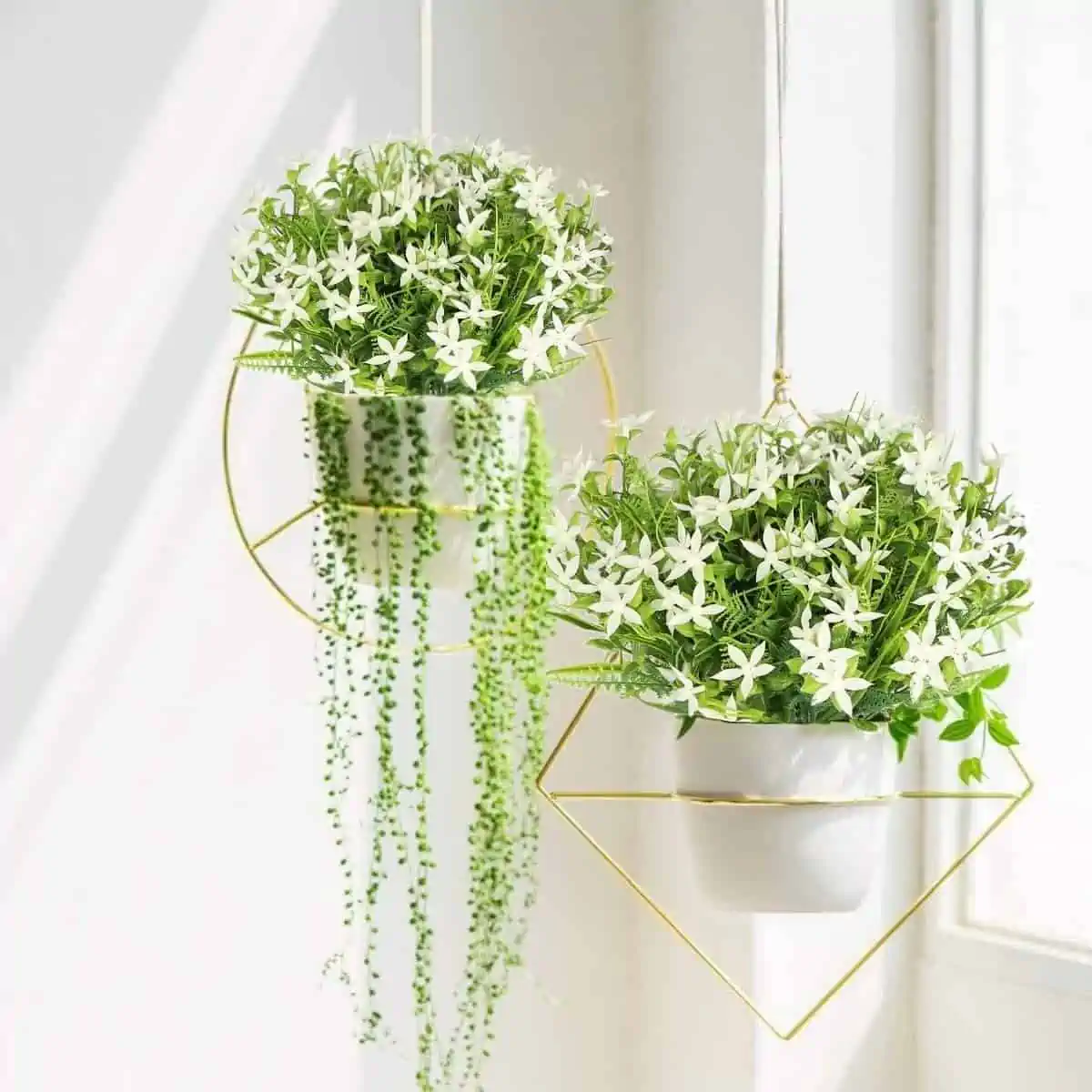A Jasmine plant is a group of vines and shrubs that belong to the Oleaceae family, also known as the olive family. Its botanical name is Jasminum, and it comprises around 200 species that are native to tropical areas of Southeast Asia, Australia, and Africa. Jasmine flowers are widely known for their sweet fragrance and can be both white and yellow. Their beauty and sweet scent make them a great addition to homes. There are several varieties of Jasmine available in the market, and we have compiled a list of those found in India. So, if you want to enliven your home with the sweet scent of Jasmine, take a look at our comprehensive guide to growing, caring for, propagating, and incorporating this aromatic plant into your room decor. Also, check out our gallery filled with stunning images of Jasmine flowers for home decor inspiration.
Contents
- 1 About Jasmine plant – An overview
- 2 Benefits of the Jasmine plant
- 3 Varieties of Jasmine plant
- 4 How to grow Jasmine plant indoors
- 5 Watch this video: How to grow Jasmine? (3 mins 14 seconds)
- 6 Care and propagation of Jasmine plant
- 7 Pests, problems, and diseases
- 8 Shop for beautiful Jasmine plants here!
- 8.1 Floweraura, Ixora Jasminum Combo
- 8.2 Wildroots, Jasminum sambac, Mogra
- 8.3 Nursery Live, Juhi, Jasminum Auriculatum
- 8.4 Santhi Online Plants, Stare Jasminum (Colour Kagattan)
- 8.5 Metro Nursery, top 4 All Year Flowering Plants Pack
- 8.6 Farmerr, Kakada
- 8.7 Nursery Live, Jasminum sambac, Mogra
- 8.8 Nursery Nisarga, Kunda, Downy Plant
- 8.9 Farmerr, Jasminum Grandiflorum
- 8.10 Budsnblush, Chameli Plant
- 9 16+ ways to liven your home decor with flowers (Image gallery)
- 10 FAQs
- 11 Conclusion
About Jasmine plant – An overview
| Common names | Summer Jasmine, white Jasmine, true Jasmine |
| Botanical name | Jasminum officinale |
| Family | Oleaceae |
| Plant type | Shrubs and vines |
| Mature size | 10-15 ft. |
| Sun exposure | Partial, shade |
| Soil type | Loamy, well-drained |
| Soil pH | 6.5-7.5 |
| Bloom time | March to June |
| Flower colour | White, pink, and yellow |
| Foliage colour | Green |
| Hardiness zones | 7 to 11 (USDA) |
| Season features | Fall bloom, spring bloom, and winter bloom |
| Native area | Africa, Eurasia, Oceania, and Australasia |
Benefits of the Jasmine plant
Jasmine plant, when kept indoors, incorporated into your diet, or used as an essential oil, can have a plethora of benefits, as discussed below.
Relaxes and relieves stress
Jasmine flowers have an enchanting smell that not only pleases the senses but also provides relaxation. Their scent can eliminate stress and therefore is a preferred house plant.
Neutralizes and purifies the air
The plant serves as a natural air purifier, making it a great addition to indoor decor. At the same time, the fragrance produced from its flowers helps in eliminating foul odours, thereby neutralising the air.
| Also read: Lily flowers: Ultimate guide to grow & style various types (Buy now!) |
Helps in sleep
The aroma of its flowers can encourage stress-free sleep. So, keeping this aromatic plant in your bedroom can help you get better sleep.
Provides health benefits
This aromatic plant offers a plethora of health benefits, such as aiding in weight loss, easing muscle pain, or acting as a natural wound healer.
| Also see: Hibiscus: Guide to growing, caring & decorating (32+designs) |
Varieties of Jasmine plant

Image Source: All About Gardening
There are several varieties of these plants grown worldwide. We have compiled a list of popular varieties grown in India.
Common Jasmine

Image Source: Worldoffloweringplants.com
Also known as True or Poets’ Jasmine, it is widely grown in India. The flowers of common Jasmine generally have five petals, pointed leaves, and a strong scent.
Arabian Jasmine

Image Source: Peppyflora.com
This variety of Jasmine plants is native to the eastern Himalayas and grows all year round. In India, it is popularly known as Mogra.
Yellow Jasmine

Image Source: Nurserynisarga.in
In this variety, the fragrant Jasmine flowers have a distinct yellow colour. It is well suited to cold temperatures and is native to the Himalayas.
Cape Jasmine

Image Source: Britannica.com
This variety is high maintenance and grows well in warm climates. A distinctive feature of this variety is the radiant emerald-green foliage it adorns.
Night blossoming Jasmine

Image Source: Dengarden.com
It is usually a house plant with the ability to survive in subtropical climates. However, they can also be grown indoors in colder climates. It is the strongest scented variety that blossoms at least four times a year.
Wild Jasmine

Image Source: Commons.wikimedia.org
This variety sports a beautiful yellow Jasmine flower; however, it does not have any scent. It is a low-maintenance plant with the ability to survive a drought.
Royal Jasmine

Image Source: Herbco.com
The royal Jasmine flowers are the largest found in any variety. However, they have a subtle scent. They are widely cultivated for ornamental purposes and are mentioned in Ayurveda for their use as herbal medicine.
Star Jasmine

Image Source: Timescolonist.com
While it does not belong to the Jasmine family, it is often included because of its close resemblance to the plant. It is also a highly fragrant vine plant bearing beautiful white flowers.
Primrose Jasmine

Image Source: Wikipedia.com
The flowers of this variety have a yellow colour and come with dark green foliage. This variety of Jasmine thrives vigorously and requires proper pruning.
| Also see: Decorative flower digest: 29+ tasteful styling & buying ideas |
How to grow Jasmine plant indoors
Before you start, be mindful that not all varieties of this plant are scented. Additionally, Jasmine flowers give off a mild to strong scent depending upon the variety. So, pick a variety depending upon the strength of fragrance you prefer. Also, there are dwarf varieties of Jasmine, which are ideal for being used as houseplants. With that in mind, let’s have a look at how to grow this aromatic plant indoors.
Start outdoors
Initially, allow the plant to grow outdoors during summer and again during the autumn months for a period of 6 weeks.
Temperature control
Ensure that the plant is not overheated and the soil doesn’t dry out. When the buds are developing, make sure that the plant is kept in a cool, well-lit, but unheated room. This provides an ideal environment for the plant to grow.
Moisture level
The soil for growing your indoor Jasmine plant must be porous and moist. Ensure that the soil does not turn soggy.
Feeding time
Ideally, this plant has to be fertilised with phosphorous and potassium-rich fertilizer twice a year. However, liquid fertilizer can be fed to the plant every few weeks during spring and summer.
Proper pruning
Jasmine plants are known for being voracious climbers. Therefore, they require regular trims to keep them under control. It’s important to trim the plant immediately after blooming to avoid chopping off fresh buds accidentally.
| Also see: Peace lily plant care & styling: Ideal indoor growing guide (Buy it!) |
Watch this video: How to grow Jasmine? (3 mins 14 seconds)
Care and propagation of Jasmine plant
Potted plants must be fed twice a year with fertilizer as they do not have access to extra nutrients. When watering your plant, ensure that you water it from the bottom to prevent spotting on the leaves. It would help if you also examined it regularly for pests. The roots of a potted plant wrap themselves around the pot after a certain amount of time. When that happens, it is time to repot the plant.
There are three methods to propagate a Jasmine plant:
Cuttings
It is an easy way to propagate a Jasmine plant. Just follow the steps laid out below –
- Get a cutting of a Jasmine plant. Ideally, this can be done during the fall, when the plant already needs a trim.
- Begin by cutting a 4 to 6 inches stem tip of semi-hardwood Jasmine. Be cautious of using only sterile pruning shears to avoid any fungal or bacterial infections.
- Remove spent blooms and lower leaves of your cutting. Be mindful to leave at least three upper leaves on each cutting.
- Now dip the ends in a rooting powder. This aids in encouraging the growth of the plant.
- Finally, put the cutting into a damp potting mix.
Seed
Not all varieties of Jasmine produce seeds. However, this method can be useful for the ones that do. Follow these key tips –
- Soak the seeds in warm water for at least a day.
- Then, sow a single seed in seed compost and cover the seed with a light layer of soil.
- After sowing, ensure that the seed gets plenty of direct sunlight and consistent watering.
Air layering
This propagation method works best during spring or early summer. The following are the main steps involved in this method –
- Using a sharp blade, make two horizontal scrapes around 0.5 to 1 inch long, at least 12 to 18 inches above the tip of the stem.
- Make a vertical scrape and peel off the bark.
- Then scrape off the green layer beneath the bark.
- Cover the wounded portion of the plant with rooting hormone and wrap it in damp sphagnum moss. Cover everything using plastic wrap.
- Ensure that the moss remains moist until roots begin forming.
- Finally, after the roots form, separate the plant by cutting the stem beneath the roots and removing the plastic.
| Also see: Grow gorgeous Dahlias with these tips for A+ home decor (Buy now!) |
Pests, problems, and diseases
If you notice yellowish leaves, it means that the plant needs to be fertilized. Also, Jasmine houseplants tend to attract mealybugs that live under their leaves and on their stems. To get rid of these pesky bugs, take a cotton swab and dip it in alcohol, then use it to remove the bug.
If you have a spider mite-infested plant, then you need to cut off the infested area and spray the plant weekly to ensure that these mites don’t return. If your jasmine has a caterpillar problem, then the application of a Bacillus Thuringiensis product will help.
Shop for beautiful Jasmine plants here!
We have curated a list of buying options with images of Jasmine flowers for your convenience. Buy one for yourself from the options displayed below –
Floweraura, Ixora Jasminum Combo
| B U Y H E R E |
Wildroots, Jasminum sambac, Mogra
| B U Y H E R E |
Nursery Live, Juhi, Jasminum Auriculatum
| B U Y H E R E |
Santhi Online Plants, Stare Jasminum (Colour Kagattan)
| B U Y H E R E |
Metro Nursery, top 4 All Year Flowering Plants Pack
| B U Y H E R E |
Farmerr, Kakada
| B U Y H E R E |
Nursery Live, Jasminum sambac, Mogra
Nursery Nisarga, Kunda, Downy Plant
| B U Y H E R E |
Farmerr, Jasminum Grandiflorum
| B U Y H E R E |
Budsnblush, Chameli Plant
| B U Y H E R E |
16+ ways to liven your home decor with flowers (Image gallery)
Take a look at our display of images of Jasmine flowers to get a better idea of how to style and place the plant indoors to enliven your space.
-
1. Image Source: FlowerCouncil.co.uk
-
2. Image Source: FriendLynettle.com
-
3. Image Source: Maisondecinq.com
-
4. Image Source: Mooiwatplantendoen.nl
-
5. Image Source: FineGardening.com
-
6. Image Source: Forum.GardenersWorld.com
-
7. Image Source: Friedrichstrauss.de
-
8. Image Source: RhsPlants.co.uk
-
9. Image Source: glut.co.uk
-
10. Image Source: ReadingMyTeaLeaves.com
-
11. Image Source: Svrinfotech.net
-
12. Image Source: TheJoyofPlants.co.uk
-
13. Image Source: Theonlinesecretgarden.com
-
14. Image Source: WhiteFlowerFarm.com
-
15. Image Source: FirstCry Parenting
-
16. Image Source: FloraQueen
-
17. Image Source: Aplnj.com
| Also see: Home decorating ideas: Top 15 trends to portray your personality |
FAQs
When does Jasmine flower?
Jasmine flowers typically bloom in the spring and summer months. In India, jasmine flowers generally bloom during the summer and monsoon seasons. The exact flowering period may vary slightly depending on the region and specific climatic conditions. However, it is common to see jasmine flowers in full bloom from April to September in different parts of India.
How do I protect Jasmine in winter?
To protect jasmine plants during winter, follow these steps:
- Apply organic mulch around the plant to insulate the soil.
- Lightly prune to remove dead branches.
- Cover the plant with cloth or burlap in harsh winters.
- Choose a sheltered planting location and water sparingly.
These measures help safeguard the jasmine plant from cold temperatures and frost, ensuring its survival for healthy growth in the upcoming spring.
Where is the best place to plant Jasmine?
The best place to plant jasmine is in a location that receives ample sunlight, preferably full or partial sunlight for at least six hours a day. Jasmine thrives in well-draining soil that is rich in organic matter. It is also beneficial to choose a planting spot that offers protection from strong winds as jasmine plants can be delicate and may suffer from wind damage. Additionally, consider planting jasmine near a trellis, fence, or wall to provide support for its climbing or sprawling growth habit.
Where to plant Jasmine as per Vastu?
According to Vastu Shastra, jasmine plants are believed to bring positive energy and good luck when planted in specific directions. It is recommended to plant jasmine in the north, east, or northeast direction of the house or garden. These directions are considered auspicious and are associated with prosperity and growth.
| Also read: Vastu Shastra: Design principles & tips to invite positivity in home |
Can Jasmine tolerate the full sun?
Yes, these plants generally tolerate full sun well. They thrive in bright sunlight. However, in regions with extremely hot climates, some jasmine varieties may benefit from partial shade during the hottest part of the day to prevent excessive heat stress. It’s important to provide adequate water and ensure proper soil moisture when growing jasmine in full sun to prevent dehydration.
How to grow Jasmine plants indoors?
To grow these plants indoors, select a suitable variety. Use a well-draining pot with drainage holes and fill it with a potting mix enriched with organic matter. Place the plant in a bright location that receives indirect sunlight for several hours a day. Also, maintain a moderate to high humidity level and avoid overwatering. In addition, feed the plant with a balanced fertilizer during the growing season and prune it regularly to maintain its shape.
With proper care, these plants can flourish indoors, filling your space with their delightful fragrance and beautiful blooms.
| Also see: 15 Best indoor planters to give your space a style boost (Buy now!) |
Conclusion
Incorporating plants in home decor is an easy way to beautify your space while simultaneously enjoying the myriad benefits it offers. Preferred by nature lovers living in an urban landscape, the right variety of indoor plants that purify the air is a good investment for your long-term health. This aromatic plant is particularly appealing because it not only purifies the air but also fills the room with its pleasant aroma. The aesthetic images of Jasmine flowers are a testament to how this plant can beautify your space.
So, if you want to incorporate this delightful plant indoors and enjoy its pleasant scent filling your space, feel free to use this article as a guide to understanding how to plant, care for and buy one to revamp your indoors. Also, get inspired by the images of Jasmine flowers in a home setting displayed here to use this aromatic plant to enhance your indoors.
*The featured image used in this article is from Gardening Know How





















































